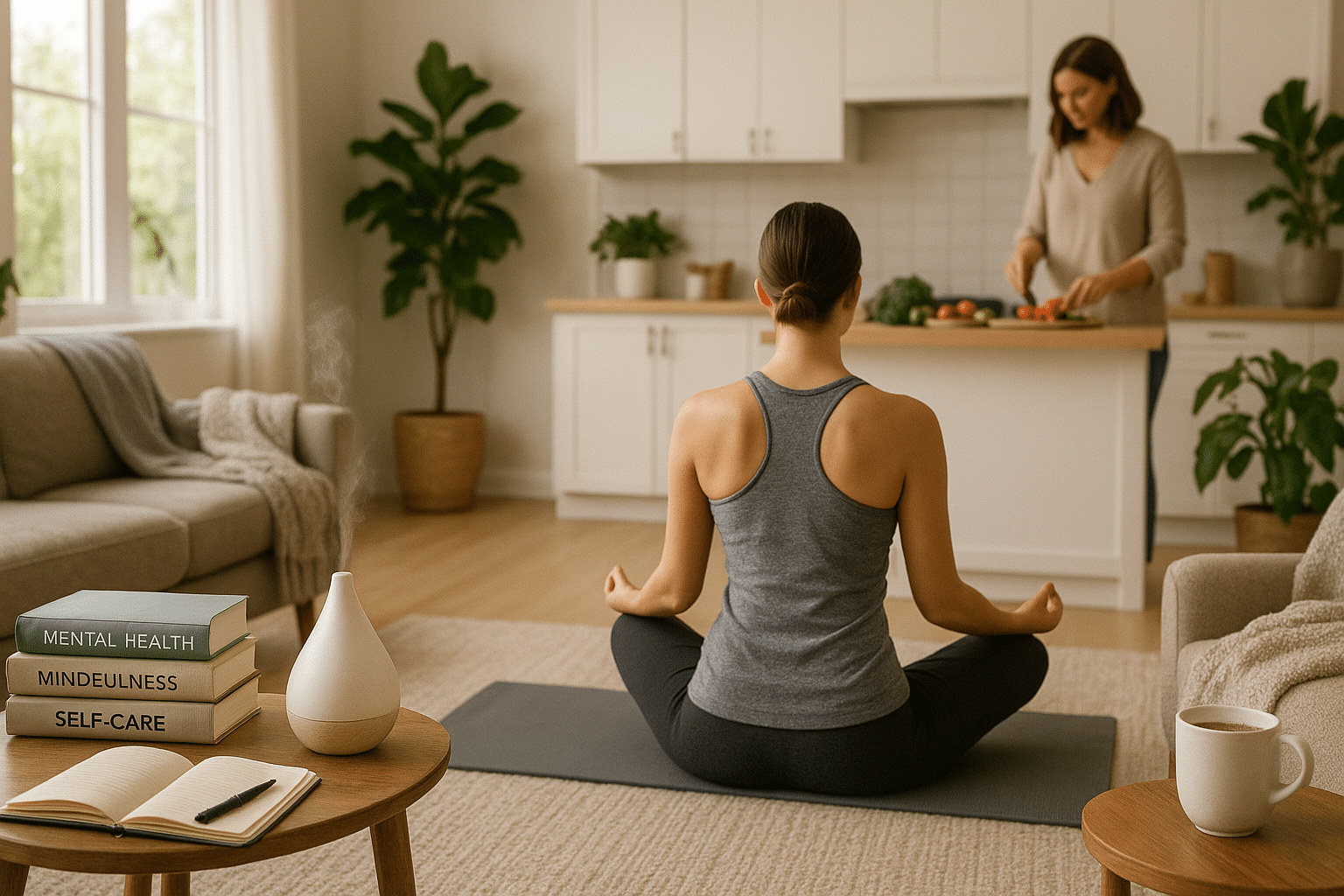🧘♀️ We live in a fast-paced world 🌐 where burnout is increasingly common. In the face of stress and pressure, many of us have turned to self-care as a means of preserving our mental health. The notion of self-care has been popularized, often portrayed in the form of bubble baths 🛀, face masks, and pampering sessions. But is that all there is to wellness?
Contrary to what many believe, wellness is not just about indulging in relaxing activities or treating ourselves to luxurious experiences. It goes beyond that. It’s about taking care of our overall health—physical, mental, and emotional—and nourishing our inner selves.
But, wait! 🛑 Before we dive deeper into the topic, let’s clarify what we mean by self-care and wellness, as these terms are often used interchangeably. Self-care refers to activities that we do deliberately in order to take care of our mental, emotional, and physical health. These activities can range from taking a bubble bath 🛀 to reading a book 📖, to meditating 🧘♀️. Wellness, on the other hand, is a state of being in good health, especially as an actively pursued goal. It encompasses several dimensions, including emotional, occupational, physical, social, intellectual, and spiritual well-being. So, while self-care is a part of wellness, it is not the whole picture.
So, why isn’t self-care enough for true wellness? 🤔
Well, that’s what this blog post is all about! We’re going to explore why self-care alone isn’t enough and why we need a holistic approach to wellness that includes various aspects such as physical health, mental health, emotional health, and spiritual health. We will also delve into some effective strategies for achieving true wellness.
Yes, self-care is important. But it’s just one piece of the wellness puzzle. 🧩 The other pieces involve a balanced diet 🥗, regular exercise 🏋️♂️, quality sleep 😴, maintaining social connections 🤝, and mental stimulation 🧠. And let’s not forget about managing stress and finding a sense of purpose and fulfillment in life.
By the end of this blog post, we hope to give you a better understanding of what true wellness entails and why it’s important to look beyond the bubble baths and face masks. This knowledge will empower you to take steps towards achieving true wellness in your own life.
So, whether you’re a self-care enthusiast looking to enhance your wellness journey, or someone who’s curious about the concept of wellness, or even a wellness skeptic, this blog post is for you. Let’s delve into the world of true wellness beyond bubble baths, shall we? 🌿
Remember, wellness is not a destination, but a journey. 🛤️ Let’s embark on this journey together, exploring the various dimensions of wellness and how we can cultivate them in our lives. Ready to dive in? Let’s go! 💪
Unraveling the Mysteries of Self-care: A Deep Dive into its Intricacies
In today’s fast-paced world, self-care has become a buzzword, a panacea for all sorts of emotional, mental, and physical strains we encounter daily. From bubble baths to yoga sessions, everyone seems to have their version of self-care. However, these practices alone might not lead to true wellness. True wellness encompasses a broad spectrum of aspects, including emotional, mental, physical, and social well-being.
So, how do we approach self-care in a way that leads to true wellness? Let’s dissect this complex concept and discover why self-care alone isn’t enough for genuine well-being. We’ll start by understanding what self-care truly means.
Self-care refers to activities that individuals undertake to maintain their health, well-being, and happiness. These activities might range from taking a long bath to reading a book, meditating, exercising, or even just sitting in silence. However, self-care should not be limited to these activities; it’s a lifelong commitment to maintaining one’s health and well-being. It’s about creating balance in life and ensuring our physical, emotional, and mental health is taken care of.
Is Self-care Alone Enough? The Misconceptions and Realities
Many people, swayed by the barrage of Instagram posts and blogs touting self-care routines, might believe that a bath bomb or a yoga session can erase all life’s stresses. While these activities can offer temporary respite, they do not address the root cause of stress and anxiety. This is where the misconception lies: self-care isn’t just about pampering yourself; it’s about taking care of your overall well-being.
That’s not to say that these activities are unimportant. They play a crucial role in maintaining our mental health and can provide much-needed relaxation and stress relief. However, to achieve true wellness, it’s essential to delve deeper and address the underlying issues contributing to stress and anxiety.
To better understand this, let’s look at the comparison table below, highlighting the differences between superficial self-care and comprehensive self-care leading to true wellness.
| Superficial Self-care | Comprehensive Self-care |
|---|---|
| Temporary stress relief | Long-term stress management |
| Focused on physical relaxation | Emphasizes emotional, mental, and physical health |
| Provides short-term happiness | Focuses on long-term well-being and happiness |
The Pillars of True Wellness: Beyond Self-care
Now that we’ve established that self-care alone isn’t enough for true wellness, it’s crucial to understand what constitutes genuine well-being. True wellness is a holistic concept that involves several aspects of our lives. Let’s discuss the pillars of true wellness, which extend beyond basic self-care practices.
Physical Health
While regular exercise and a healthy diet are part of physical health, true wellness goes a step further. It’s about understanding our bodies and listening to what they need. This could mean knowing when to rest, staying hydrated, getting regular health check-ups, and seeking medical help when needed. For an insightful video on maintaining physical health, check out “10 Tips for Healthy Lifestyle & Healthy Living- How to be Healthy!” by Dr. Hansaji Yogendra on YouTube.
Mental and Emotional Health
Mental and emotional health is often neglected in the discourse of self-care. True wellness involves recognizing and addressing our feelings, seeking help when needed, and adopting practices that promote mental health. This might include therapy, meditation, mindfulness, and ensuring a work-life balance. Watch “How to get stuff done when you are depressed | Jessica Gimeno | TEDxPilsenWomen” on YouTube to understand how mental health impacts our lives.
Social Health
Social connections play a vital role in our overall well-being. Building and maintaining healthy relationships contribute to our happiness, reduce stress, and provide a support system. Therefore, it’s important to nurture these relationships and invest time in them. For more on this, watch “The hidden influence of social networks | Nicholas Christakis” on YouTube.
As we delve deeper into the concept of true wellness, it becomes clear that self-care is just the tip of the iceberg. It’s not just about pampering ourselves but about adopting a holistic approach to our overall well-being. It’s about living a balanced life, addressing our needs, and taking care of our physical, emotional, and mental health. While self-care practices are part of this journey, they are not the destination. So, next time you run a bath or meditate, remember that these are just stepping stones on the path to true wellness.

Conclusion
In conclusion, it is clear that we have extensively journeyed through the intriguing and highly technical world of Software Engineering. We have explored its definition, history, and various aspects such as software design, coding, software testing, and maintenance. Additionally, we have touched on the essential principles of software engineering, including the various methodologies applied in this field.
Software Engineering is undoubtedly a field that combines both the artistic flair of design and the precision of science. It’s a rapidly evolving field that plays a critical role in almost every aspect of our daily lives, from the applications we use on our mobile devices, to the systems that run our cars and homes. It’s therefore crucial to understand and appreciate its importance in this technologically driven age.
We have also uncovered the importance of the Software Development Life Cycle (SDLC) and its different models, such as the waterfall model, the iterative model, the spiral model, the agile development model, and the DevOps model. These models are vital in understanding the process of software development and can greatly influence the success of any software project.
It’s also important to remember the role that software quality assurance plays in ensuring that software is reliable, efficient, and meets the specified requirements. This is achieved through rigorous testing and validation processes, and as we have seen, it is an integral part of the software engineering field.
Additionally, we have discussed the significance of various software engineering tools and their role in streamlining and simplifying the software development process. These tools help to improve productivity, reduce errors, and facilitate collaboration amongst team members.
Finally, we took a deep dive into some of the future trends in software engineering, including artificial intelligence, machine learning, big data, and the Internet of Things. These technologies are set to revolutionize the software engineering landscape, offering exciting opportunities for innovation and growth.
In light of all these fascinating insights, it’s clear that software engineering is a critical field that continues to drive innovation in various sectors. It’s a dynamic, challenging, and rewarding field that offers endless opportunities for those who are passionate about technology and problem-solving.
I encourage you to delve deeper into this topic, explore additional resources, share your thoughts, and even apply some of these concepts in your own projects. To facilitate further research, you may find these resources helpful:
– IEEE Conferences and Events
– ACM Conferences
– IEEE Computer Society Technical Committees
Remember, the field of software engineering is vast, and there’s always something new to learn! So, keep exploring, keep learning, and keep pushing the boundaries of what is possible in this incredible field! 🚀👩💻👨💻
Please feel free to leave your comments below and share this article with your peers. Let’s continue the conversation and learn from each other. Together, we can make great strides in the world of software engineering. 🌐💡
Please use the following tags when sharing this post: #softwareengineering #technology #innovation
Thank you for reading, and remember, in the realm of software engineering, the only limit is your imagination! 💫



